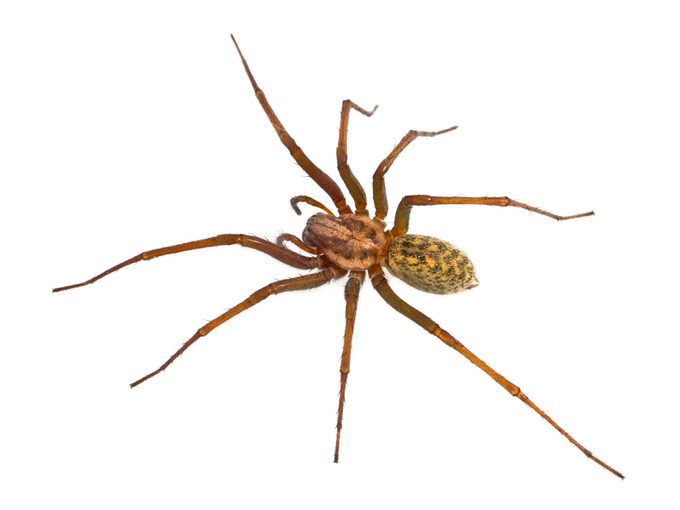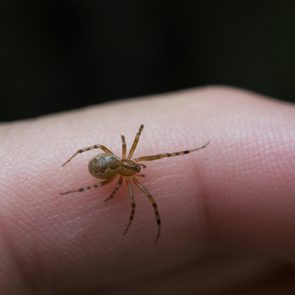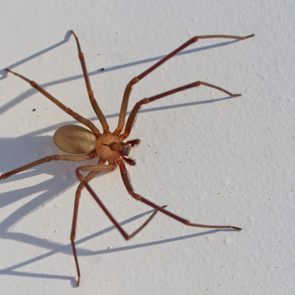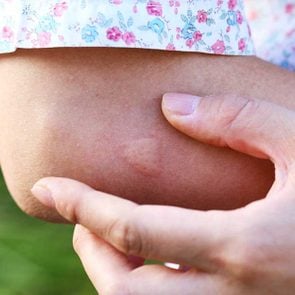Hobo Spider Bites: Everything You Need to Know
Updated: Dec. 04, 2020
Hobo spiders are not actually aggressive and they rarely bite. However, if you get a hobo spider bite, here's what you need to know, including pictures of bites, symptoms, and treatments.
Our editors and experts handpick every product we feature. We may earn a commission from your purchases.
The hobo spider hardly deserves the reputation of the “aggressive” house spider. Yes, they look intimidating and can sprint across the floor—and by sprint we mean they can run a distance equivalent to 330 times their body length in 10 seconds. However, chances are if you see one, it’s not running towards you to inject a toxic venom.
The truth is this spider rarely bites. They only act aggressively on two occasions: if a predator shows aggression toward its prey and if it’s trapped against human skin with no place to flee. Here’s what you should you need to know about them and what to do if you get bitten.
On This Page
Are brown recluse and hobo spiders the same?
A hobo spider has the unfortunate problem of often being mistaken for a brown recluse spider. Both arachnids are similar in size and brownish, but that’s where most of the similarities end.
The hobo spider has brownish-yellow markings on the abdomen, while the brown recluse has a violin-shaped marking on its body.
Where hobo spiders can be found
In the United States, the hobo spider lives in the Pacific Northwest, in Montana, Wyoming, Colorado, Oregon, and the northern parts of Utah. The brown recluse, on the other hand, lives in the South Central and Midwestern U.S. regions. And the behavior of hobo and brown recluse spiders differ too. You’re more likely to see a hobo spider scurry across the floor than the brown recluse, which prefers to stay hidden.
Web-wise, hobo spiders are prolific web builders and spin flat, trampoline-like funnel webs to catch their prey (unlike their relative, the wolf spider). The brown recluse spins sparse, small webs and hunts its prey rather than using a web to catch it. Both spiders bite (though it’s rare), and were considered poisonous. But the Centers for Disease Control and Prevention (CDC) removed the hobo spider from its list of venomous spiders in 2015, due to a lack of scientific evidence that hobo spiders cause necrotic bites (skin death) in humans.
“All incriminations of hobo spiders were based on circumstantial evidence,” says Rick Vetter, a retired entomologist, University of California, Riverside, and author of The Brown Recluse Spider.
 How do I avoid getting bitten?
How do I avoid getting bitten?
It’s easier than you think to avoid a hobo spider bite because hobo spiders spend their time lying in wait to capture and eat flies, ants, cockroaches, and other insects—not human flesh. They don’t feast on human skin or blood. Arachnologist Catherine Scott, PhD, at Acadia University in Wolfville, Nova Scotia, Canada, says spiders rarely bite people except in extreme situations such as being trapped between human skin and themselves with nowhere to escape.
More good news: they spend most of their time outdoors. Although a few may wander indoors when the temperatures fall. Inside, you might occasionally see one running across the floor, but it is highly unlikely one would be scaling the walls as they’re not good vertical climbers. Yet sometimes hobo spiders manage to find their way into a bathtub or bathroom sink. It’s probably because they were seeking moisture, but couldn’t climb back out and got stuck there.
What to do if you find a hobo spider (or its web)
You can flush the spider down the drain or capture and release it outside. If the webs are a nuisance or the sight of a spider freaks you out, use sticky traps next to doors, along the baseboards, and near window wells. To avoid skin-to-spider contact, shake out clothing, shoes, and other objects before using them. Inspect wood, patio furniture, plants, and other outdoor objects before bringing them inside. Reduce clutter and vacuum frequently to also prevent contact with hobo spiders.
https://www.instagram.com/p/p48U8crysT/
What are the symptoms of a hobo spider bite?
A bee sting would probably be more painful than the bite of a hobo spider. In fact, you probably won’t feel it at all. Noticeable symptoms will be minor.
“The only consistent ones are redness and swelling. The redness may last up to 12 hours,” says dermatologist Adam Friedman, MD, professor and interim chair of dermatology and serves as residency program director, director of translational research, and director of the supportive oncodermatology program in the department of dermatology at The George Washington University School of Medicine & Health Sciences in Washington, D.C.
However, it’s wise to call a doctor to discuss any redness or swelling that doesn’t go away in a couple of days because the symptoms may not be that of a spider bite. There are several conditions commonly misdiagnosed as a result of a suspected spider bite. A study published in Surgical Infections shows 30 percent of people who thought their skin lesions were the result of spider bite actually had methicillin-resistant Staphylococcus aureus (MRSA) bacterial infections. MRSA is a type of bacteria that is often resistant to many antibiotics.
Meanwhile, an American Family Physician 2013 study found 80 percent of suspected spider bites were actually due to arthropod bites, such as ticks. Not to mention the fungal and viral infections, Lyme disease, and even skin cancer symptoms have been mistaken for spider bites.
I think a hobo spider bit me: What now?
If you feel confident that it was an indeed a hobo spider bite and not something else, don’t panic. Hobo spiders don’t release a poisonous venom and some don’t inject venom at all when they bite.
“Venom is valuable to spiders and it takes a lot of energy to make. Spiders reserve that to catch food,” says Sebastian Alejandro Echeverri, PhD, who studies spiders at the University of Pittsburgh.”
Even the venomous black widow and brown recluse spiders rarely inject venom when they bite, Echeverri says.
How should I treat a hobo spider bite?
You can treat a hobo spider bite at home. Dr. Friedman suggests the following first aid protocol if you suspect a hobo spider bite:
- Clean the bite with soap and warm water
- Apply ointment based moisturizer to damp skin and keep covered with a Band-Aid if possible
- Take acetaminophen or ibuprofen (so long as not contraindicated) if you have pain
- Apply ice briefly or hydrocortisone one percent cream if you have itching
Additional resources
Spiders are incredibly beneficial to humans because they trap and eat insects such as flies, mosquitoes, and ants. Find out more fascinating facts about spiders, their webs, and behavior from the experts who study them.
- Spiderdaynightlive.com, a website by Sebastian A. Echeverri, PhD
- Spiderbytes, a blog by Catherine Scott PhD, department of biological sciences, University of Toronto Scarborough























